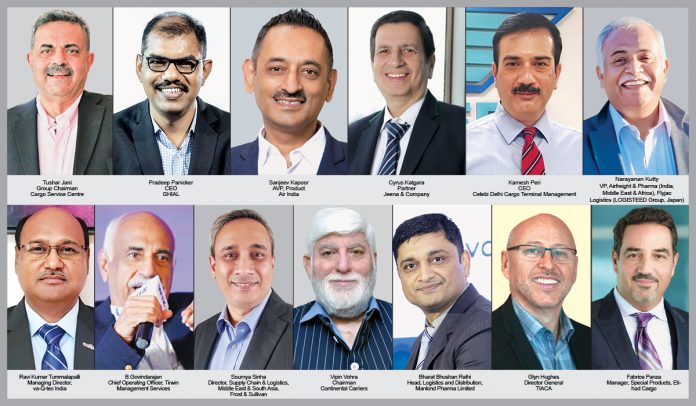India’s contribution to the global pharmaceutical industry is truly remarkable. India is the world’s largest supplier by volume of generic drugs and around 62% of the world’s total vaccines are manufactured in India. With such robust manufacturing capabilities, Indian pharma firms have potential to increase exports globally.
Ritika Arora Bhola
India is the only country to have the highest number of United States Food and Drug Administration (USFDA)-approved facilities and plants outside of the USA. Gaining this approval provides pharma companies with many advantages such as establishing international credibility for their commitment to maintaining the highest quality standards, gaining clinical trial opportunities to develop new drugs that are cost-effectively manufactured. This gives them access to the USA pharmaceutical market, which will boost their global reach and export volumes. It is creating a positive impact on the global level with its commitment to manufacturing affordable and high-quality medicines.
The Indian government’s support has helped the sector grow, overcoming many challenges, and opening many opportunities to become a major pharmaceutical exporter globally. According to Frost & Sullivan’s latest report, there is an impact of the government initiatives on enhancing Indian pharmaceutical exports:
The Indian government launched Production Linked Incentive schemes to boost domestic manufacturing, which strengthens localisation and increases pharmaceutical exports globally.
Below are the PLI schemes that are related to the pharma sector:
Focusing on domestic manufacturing: The government has started implementing policies on critical key starting materials, drug intermediates, and Active Pharmaceutical Ingredients (APIs) to grow domestic manufacturing capabilities. The Indian government will invest `69.4 billion for a period of six years, until 2029-2030. The scheme aims to promote domestic manufacturing of the 53 crucial KSMs, drug intermediates, and APIs by providing financial incentives. This will reduce dependence on imports, bring new investments, increase domestic production, foreign exports, and create new employment opportunities.
PLI scheme for pharma (2021): The Indian government will invest `150 billion over six years to enhance pharma manufacturing capabilities and offer incentives to diversify product offerings towards high-value segments. This will elevate the reputation of the Indian pharma sector, leading to stronger global partnerships, gaining access to new markets, increasing demand and boosting exports.
Scheme for promotion of bulk drug parks: Indian pharma firms depend on imported bulk drugs, which are used in manufacturing final medicinal products. This scheme addresses the issue and promotes the construction of three bulk drug parks in Gujarat, Andhra Pradesh, and Himachal Pradesh. These zones will boost local manufacturing of bulk drugs (APIs), drug intermediates, and KSMs. This will help reduce supply chain disruptions, increasing Indian pharma exports, while ensuring low manufacturing costs, stable prices, and quality medicines. CARGOTALK speaks to experts on the current status of the pharma exports and government initiatives to boost it.
Develop capability to enhance cross-border pharma e-commerce
Tushar Jani, Group Chairman, Cargo Service Centre
I believe 70 to 75 per cent of generic drugs today are exported to Europe and the United States of America from India. Our pharmaceutical industry is doing a fantastic job and getting regular Food and Drug Administration approvals from the US Drug administrators. Go to any pharmacy abroad, you will find Indian generic drugs. The important factor is this development enables us to build cross border pharmaceutical e-commerce capabilities out of India. If we develop the capability of providing pharmaceutical e-commerce services, the world will recognise us, and that is what is needed. Domestic pharmaceutical industry would benefit greatly from this vision. We must develop our skills for product delivery to Europe and the USA in a controlled manner. That is where investment is needed from the Indian service providers to give good and safe pharmaceuticals to the world
Intensifying technology to enhance operational efficiency
Pradeep Panicker, CEO, GHIAL
India’s strategic positioning presents it as a potential global cargo hub, bolstered by a thriving economy, supportive policies, and ongoing infra advancements. ‘Make in India’ initiative, coupled with the China+1 strategy provides an avenue for increased global manufacturing shares. Initiatives, including export promotion schemes and FTAs aim to enhance competitiveness and market access for Indian exporters. Airline operators are poised for fleet expansions to augment cargo capacity. Cutting-edge technology such as AI, Blockchain is imperative for optimising cargo’s operational efficiency. Absence of wide-body freighter aircraft impedes access to long-haul destinations, while regulations and lack of coordination exacerbate delays in air cargo operations. Coordination among the stakeholders and addressing infrastructure deficits are crucial towards optimising India’s industry.
Necessary infrastructure created for pharma exports
Sanjeev Kapoor, AVP, Product, Air India
Indian medical exports are likely to reach `75,000 crore in the coming days, and we can see pharma firms expanding their horizon globally. Terminal operators understand the need of pharma and created the necessary infra. Stakeholders are jointly working on maintaining the cold chain, while transferring cargo from warehouse to aircraft by using cool dollies and thermal blankets to avoid any excursions. The road link has improved at a high pace, making it possible for the non-metro stations to send their pharma products on reefer trucks to metro stations across India. Delhi, Mumbai, Hyderabad, and Bengaluru have facilities to handle pharmaceuticals and are planning to expand more in future.”
Govt, pvt sector investing in enhancing transportation infra
Cyrus Katgara, Partner, Jeena & Company
Substantial investments have been observed in India’s healthcare and pharma supply chain since COVID. The government has supported healthcare sector through Ayushman Bharat Digital Mission and Research-linked Incentive Scheme for promoting R&D in pharmaceuticals. They have resulted in an uptick in manufacturing, attracted investment, and encouraged consumption. India, known as ‘pharmacy of the world’, is poised for further growth. Public and private sector are investing in enhancing transportation infra. There is an integration of advanced tech such as GPS tracking, temperature monitoring systems, and remote-control mechanisms into reefer vehicles. This is geared towards improving efficiency of managing temperature-sensitive shipments, thereby optimising logistics operations.”
Technology, skilled workforce minimise risks in pharma
Kamesh Peri, CEO, Celebi Delhi Cargo Terminal Management
At Delhi airport, Celebi has a pharma logistics centre. It has pre-cool facility and four chambers with temperatures from 15⁰C to minus 20⁰C and an annual capacity of 72,000 Metric Tonnes. Our cargo ops are certified by GDP and CEIV Pharma. Collaborating with our clients, we tailor our services as per their needs. Technology plays a role in optimising cold chain transportation of pharma. Training tailored for drivers and handlers reinforce the industry’s commitment to maintain safety and quality. Collaboration among the industry stakeholders within the pharmaceuticals supply chain is essential, implementing best practices in handling pharma and minimising risks. Utilising GPS systems, monitoring shipments and temperature ensures control over the integrity of the pharma products.”
Quality deteriorates due to drivers, poor handling
Narayanan Kutty, VP, Airfreight & Pharma (India, Middle East & Africa), Flyjac Logistics (LOGISTEED Group, Japan)
Packaging of the medicines play a vital role in maintaining the quality and temperature at which these medicines need to be transported. Thermal blankets, gel packs, vac-q-techs and ‘envirotainers’ need to be used to maintain the desired parameters during transportation. While transporting, these trucks are detained for longer periods by regulatory bodies. Owing to the negligence of the drivers’ and regulatory agencies, the products’ quality deteriorates as they are handled inappropriately. Poor road infrastructure causes long transit times, and the bumpy ride impacts the quality of liquid formulations. As export from shippers reaches the terminals in the evenings, congestion caused by heavy incoming traffic leads to longer waiting periods.”
Products high in value should be in controlled environment
Ravi Kumar Tummalapalli, Managing Director, va-Q-tec India
After the pandemic enveloped the globe, industry has become cautious of supply chain challenges. Coming to pharmaceuticals, India is moving towards complex molecules, which are low in volume but high in value such as biosimilars, biologics, cell and gene therapy. Since these products are new, they need to be secured under controlled environment till there is enough data available on the product’s stability. Our company is scaling up facilities, and the government is making efforts in improving infrastructure in all areas—airports, seaports, road, rail, freight flow, to link all industrial clusters and reduce logistics cost to single digits. Today, travel time between major metropolitan cities has come down to less than five days.”
More work to be done in gateway & tier II, III airports
B.Govindarajan, Chief Operating Officer, Tirwin Management Services
Pharma and healthcare IPOs, which have been listed in Bombay Stock Exchange and National Stock Exchange since 2021, is an indication of increasing investments to scale up production. Airport cargo terminals in terms of brick and mortar are not important since they are not meant for storage and warehousing. There is more work to be done not only in gateway airports but also in tier II and III airports. A paradigm shift in deployment of reefer vehicles from traditional perishables to time-sensitive ones is seen. Monitoring and controlling temperature excursions during transportation continues to be a challenge. This can be handled by enhancing the knowledge of the drivers and providing power supply at the vehicle topping points enroute.”
Firms reaching partnerships to augment pharma exports
Soumya Sinha, Director, Supply Chain & Logistics, Middle East & South Asia, Frost & Sullivan
Globally, pharma sector is likely to grow phenomenally. To capitalise on this, the government is working on ‘Vision Pharma 2047’ to make India a global pharma hub, as the industry may reach US$130 billion by 2030. Indian pharma firms are making efforts to expand exports by leveraging strategic partnerships with global industry players. These new investments will fund cutting-edge tech to increase production capacity and create new drugs through advanced clinical trials. The government will invest `150 billion over six years to enhance pharma manufacturing and diversify product offerings towards high-value segments. This will elevate the pharma sector’s reputation, leading to stronger global partnerships, increasing demand and boosting exports.”
Govt, exporters collaborate to optimise cold storage
Vipin Vohra, Chairman, Continental Carriers
To address the challenges of distributing temperature-sensitive products, India has been implementing various strategies, including expanding cold storage facilities, transportation networks, and investing in advanced refrigeration technology to maintain the required temperature during storage. The government and stakeholders have collaborated to optimise storage solutions—cold storage units and refrigerated trucks. Improving multimodal connectivity to support transportation of time-sensitive shipments. They are investing in expanding the fleet of refrigerated vehicles, including trucks, trains, ships, and aircraft to ferry perishables safely. These facilities help in storing perishables during transit and ensure seamless transfer between different transportation modes. Infra development includes construction of cold storage facilities, off airport refrigerated warehouses, and distribution centers.”
More facilities near airports to ramp up cross border trade
Bharat Bhushan Rathi, Head, Logistics and Distribution, Mankind Pharma Limited
India plays a vital role in manufacturing of drugs. We are growing in double digits and will continue to do so for five more years. To grab this opportunity, industry is making a lot of investment. We have an integrated logistics park i.e. a single window arrangement for clearance. For instance, the facility to accommodate temperature-controlled material at Hyderabad airport. The industry is developing facilities near airports/ports to give an edge for cross border transport. We need to utilise cutting-edge tech so that live info can be accessed. Visibility is still a challenge. We have trained employees (white colour), but a lot needs to be done on product handling training to save costs.”
India tops in moving pharma to global supply chains
Glyn Hughes, Director General, TIACA
India is not only leading the way in pharma but is also leading in ensuring infrastructure and facilities are in place to move the sensitive products through global supply chains. Patients’ safety demands integrity and compliance of handling and moving pharma safely. Major Indian airports where pharma is ferried have industry and regulatory-complaint cold chain facilities. But it must be said then that this situation needs to be matched at every transit hub and destination point throughout the global network. Pharma.aero are doing well by promoting these needs globally and setting up a network of airports and supply chain partners. It is crucial when pharma is ferried, product integrity is not compromised.”
Delhi, Mumbai, Hyd, B’luru are our vital pharma gateways
Fabrice Panza, Manager, Special Products, Etihad Cargo
If we look at India specifically, the country represents 30-40 per cent of the international production of generic drugs and medicines to 200 countries. We are seeing increased flows out of India to the USA and Europe. For Etihad Cargo, Bengaluru, Mumbai, and Hyderabad are some of the important gateways commonly used out of India for pharma traffic. Hyderabad, for example, is a top healthcare and active pharmaceutical ingredients (API) commodity production and distribution area. We estimate up to 50 per cent of international flows are currently from this segment. Some of the commodities transported by air from Hyderabad require a temperature-controlled environment and advanced packaging solutions.”















